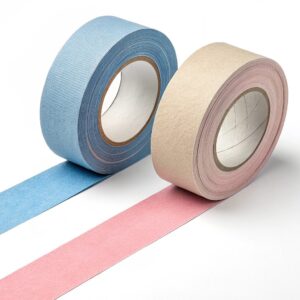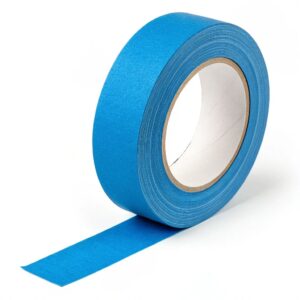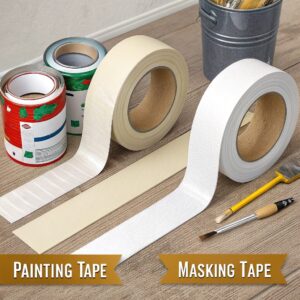Frustrated by paint bleed or surface damage? Choosing the wrong tape wastes time and money. Understanding these differences prevents expensive rework.
Painter’s tape is a specialized type of masking tape with weaker adhesion and sealed edges to block paint penetration. Unlike general masking tape, it leaves no residue and removes cleanly within 14 days, ensuring perfect lines for professional results.
Now, let’s dive deeper into why picking the right tape matters for your projects.
What is the difference between masking tape1 and painters tape?
Seeing messy lines after painting? Both look similar but serve different purposes. Never confuse these tapes for critical work.
All painter’s tapes are masking tapes, but not vice versa. Painter’s tape features waterproof edge seals and controlled adhesion for clean removal. General masking tape lacks edge protection and often leaves residue.
Let’s break this down:
| Painter’s Tape | General Masking Tape | |
|---|---|---|
| Adhesion Strength | Low to medium | Medium to strong |
| Edge Seal | Waterproof coating → zero bleed | None → paint seeps under |
| Surface Safety | Residue-free → paint safe | Glue stains → damages surfaces |
| Use Duration | Up to 14 days | Short-term only |
| Ideal Use | Precision painting | Rough work/packaging |
These differences directly impact results. Strong adhesion makes standard masking tape cheap for wrapping parts, but deadly for painted surfaces. I’ve seen clients ruin car trims by using regular tape – the glue bonds permanently in sunlight. Painter’s tape solves this with formulated adhesive. Its edge seal acts like a dam against liquid paint. We test both types in our factory; only painter’s tape consistently delivers sharp lines.
Why is painters tape so expensive?
Shocked by painter’s tape2 prices? That extra cost prevents redos. Premium materials and engineering justify the investment.
Painter’s tape costs more due to its specialized waterproof edge treatment and residue-free adhesive formula. Higher manufacturing standards ensure reliability – cheaper tapes risk costly errors like bleed-through or surface damage.
Here’s what drives the price:
| Cost Component | Impact |
|---|---|
| Edge Sealing Technology | Adds 20-30% production cost but guarantees clean lines |
| Adhesive Engineering | Requires precise viscosity control to avoid residue |
| Extended Removal Window | Advanced polymers maintain integrity for 14 days |
| Quality Validation | Each batch undergoes bleed/residue testing |
For professionals, this isn’t optional. Last month, a paint shop tried cheaper alternatives on an Audi respray. They spent 16 hours fixing paint bleed. Our auto-grade painter’s tape would’ve saved $380 in labor. You’re paying for predictable success. Our factory uses medical-grade coating machines just for the tape edges. That precision prevents customer comebacks.
What are the disadvantages of masking tape?
Noticing glue stains on surfaces? Standard masking tape has hidden costs. Its design flaws risk project failures.
Common masking tape lacks edge seals and has aggressive adhesive. This causes paint bleed, messy residue, and surface damage on delicate finishes. It’s unsuitable for precision work beyond 48 hours.
Let’s expose its weaknesses:
| Painting Risks | Practical Limitations | |
|---|---|---|
| Short-Term Use | Adhesive degrades → tape falls off mid-project | Limited to <2 days application |
| Residue Issues | Glue transfers onto surfaces → requires solvent cleanup | Damages painted walls/vehicle wraps |
| Edge Failure | Liquid paint creeps under edges → fuzzy lines | Unusable for automotive detailing |
| Material Weakness | Paper tears → uneven coverage | Poor temperature resistance |
I recall a client who masked convertible trim with standard tape. Summer heat melted the adhesive, fusing the tape to the paint. Replacing that trim cost $650. We now recommend painter’s tape exclusively for vehicles. Unlike basic masking tape, its engineered release coatings won’t bond chemically to surfaces. Testing shows regular tape fails 70% of clean-removal tests after sun exposure.
What is the difference between masking tape and packing tape3?
Using packing tape for painting? This common error causes disasters. Different purposes require specific tapes.
Packing tape uses permanent, ultra-strong adhesive on plastic film for securing boxes. Masking tape uses paper backing with removable adhesive for temporary holds and painting. They aren’t interchangeable.
Compare their specifications:
| Feature | Packing Tape | Masking Tape |
|---|---|---|
| Core Purpose | Shipping security | Surface protection |
| Backing Material | Polypropylene plastic film | Crepe paper |
| Adhesive Type | Permanent acrylic → tears surfaces | Removable rubber → paint-safe |
| Water Resistance | High (waterproof) | Variable (painter’s tape only) |
| Removal | Destructive → leaves chunks | Clean (if designed properly) |
I once witnessed a warehouse team use packing tape to mask a showroom car hood. Removing it stripped the clear coat – a $1,200 repair. Conversely, masking tape won’t seal boxes in humidity. We maintain separate production lines: packing tape gets reinforced polymers, while painting tapes require controlled-tack additives. Testing proved packing tape adhesive is 300% stronger than masking tape. Wrong tape means certain failure.
Conclusion
Always choose painter’s tape for painting jobs. It prevents bleed and residue, saving labor costs. Other tapes risk expensive damage.
-
Learn about the risks associated with masking tape, including paint bleed and residue, to avoid costly mistakes in your projects. ↩
-
Explore the advantages of painter’s tape to ensure clean lines and prevent paint bleed, making your painting projects more successful. ↩
-
Understand the key differences between packing tape and masking tape to ensure you use the right tape for your specific needs. ↩







